Microsoft Train Simulator
| Microsoft Train Simulator | |
|---|---|
 Cover Art | |
| Developer(s) | Kuju Entertainment |
| Publisher(s) | Microsoft |
| Distributor(s) | Microsoft, Ubisoft* Xplosiv, (Empire Interactive), * Atari,* |
| Director(s) | Paul Chamberlain |
| Designer(s) | Phil Marley |
| Programmer(s) | Rhona Robson |
| Artist(s) |
Dan Frith Tony Zottola |
| Platform(s) | Microsoft Windows (XP, Vista, 7) |
| Release date(s) | July 2001 |
| Genre(s) | Simulation |
| Mode(s) | Single player |
Microsoft Train Simulator (abbreviated to MSTS) is a train simulator for Microsoft Windows, released in July 2001 and developed by UK-based Kuju Entertainment.[1]
Gameplay
The simulation allows players to operate a train on various routes in Europe, Asia, and the United States. Players need to stop and start the train, couple wagons, using the computer mouse, keyboard or a hardware addition such as Raildriver to operate the controls. Sound effects are enabled.[2]
Routes
The original game featured six routes:
| Route name | Image | Featured trains | Rolling stock | AI rolling stock | Terminal stations | miles | km | Set in | Country | Notes |
|---|---|---|---|---|---|---|---|---|---|---|
| Hisatsu Line |  |
JR Kyushu | KiHa 31 | KiHa 140 | Yatsushiro to Yoshimatsu via Hitoyoshi |
53 | 85 | 2000/2001 | Japan | N/A |
| Innsbruck - St. Anton | 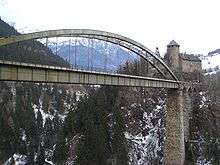 |
Orient Express | Gölsdorf 380 | Gölsdorf 310 | Innsbruck to St. Anton | 63 | 101 | 1930s | Austria | N/A |
| Northeast Corridor | 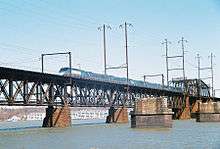 |
Amtrak | Acela Express Acela HHP-8 |
Genesis Metroliner |
Philadelphia to Washington via Baltimore |
133 | 214 | 2000/2001 | USA | N/A |
| Marias Pass |  |
BNSF Amtrak |
Dash 9 GP38-2 SD40-2 (1.2) |
Genesis SD40 |
Shelby to Whitefish, including Kalispell branchline | N/A | N/A | 2000/2001 | USA | N/A |
| Settle-Carlisle Railway |  |
LNER LMS GWR |
Flying Scotsman BR Class 50 (1.2) |
6100 Royal Scot Pendennis Castle |
Settle to Carlisle | N/A | N/A | 1920s/1930s | UK | N/A |
| Tokyo - Hakone |  |
Odakyu Electric Railway | Odakyu 7000 series LSE Odakyu 2000 series |
Odakyu 30000 series EXE | Shinjuku to Odawara | 55 | 88 | 2000/2001 | Japan | N/A |
Included with the game was the Editors & Tools program, which allowed the user to build custom routes, create activities for any route, create custom consists, create custom cabviews, or edit the default ones. The Editors & Tools program is also included with later versions of the game.
Locomotives (1.0/1.2)
The 1.0 base package contains 9 drivable locomotives and multiple units plus 8 AI locomotives/multiple units (AI units cannot be operated by the player).
| Train | Image | Ingame number | Type | mph | km/h | Built | Country | Route | Livery(s) | 1.0 | 1.2 | Player driveable | Notes |
|---|---|---|---|---|---|---|---|---|---|---|---|---|---|
| Flying Scotsman | .jpg) |
4472 Flying Scotsman | Steam | 100 | 160 | 1923 | UK | Settle-Carlisle Railway | LNER Green | Yes | Yes | Yes | N/A |
| Royal Scot |  |
6100 Royal Scot | Steam | 90 | 145 | 1927 | UK | Settle-Carlisle Railway | LMS Red | Yes | Yes | No | Features German-style smoke deflectors. |
| Pendennis Castle |  |
4079 Pendennis Castle | Steam | 75 | 120 | 1924 | UK | Settle-Carlisle Railway | GWR Green | Yes | Yes | No | N/A |
| BR Class 50 |  |
50015 Valiant |
Diesel | 100 | 160 | 1967 | UK | Settle-Carlisle Railway | BR Blue | No | Yes | Yes | N/A |
| Gölsdorf 310 |  |
310.23 | Steam | N/A | N/A | N/A | Austria | Innsbruck - St. Anton | OBB | Yes | Yes | No | N/A |
| Gölsdorf 380 | N/A | 380.119 | Steam | 43 | 60 | 1911 | Austria | Innsbruck - St. Anton | OBB | Yes | Yes | Yes | Cabview comes from Gölsdorf 180 steam locomotive |
| Dash 9 |  |
4723 | Diesel | 70 | 112 | 1993 | USA | Marias Pass | BNSF | Yes | Yes | Yes | N/A |
| Genesis | |
705 | Diesel | 100 | 160 | 1994 | USA | Marias Pass Northeast Corridor |
Amtrak | Yes | Yes | No | N/A |
| GP38-2 | .jpg) |
2081 | Diesel | 70 | 112 | 1972 | USA | Marias Pass | BNSF | Yes | Yes | Yes | N/A |
| SD40 | |
7171 | Diesel | 83 | 134 | 1966 | USA | Marias Pass | BNSF | Yes | Yes | No | N/A |
| SD40-2 | 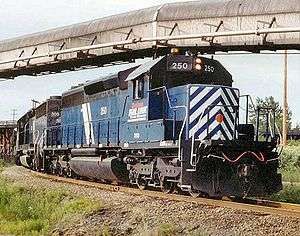 |
8010 | Diesel | 70 | 112 | 1972 | USA | Marias Pass | BNSF | No | Yes | Yes | N/A |
| Acela Express | 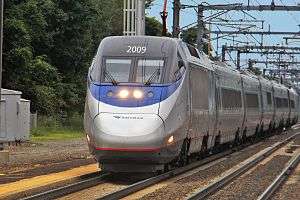 |
2001 | Electric | 150 | 240 | 1998 | USA | Northeast Corridor | Amtrak | Yes | Yes | Yes | N/A |
| Acela HHP-8 |  |
651 | Electric | 135 | 217 | 1999 | USA | Northeast Corridor | Amtrak | Yes | Yes | Yes | N/A |
| Metroliner | 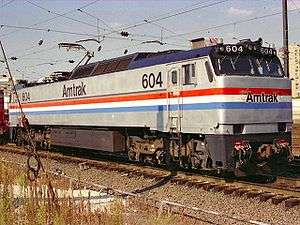 |
620 | Electric | 90 | 145 | 1972 | USA | Northeast Corridor | Amtrak | Yes | Yes | No | Uses Odakyu 2000 series sounds |
| KiHa 31 |  |
KiHa 31-12 | DMU | 60 | 95 | 1986 | Japan | Hisatsu Line | JR Kyushu | Yes | Yes | Yes | Red interior (Blue interior in passenger view) |
| KiHa 31 Isaburo Shinpei |  |
KiHa 31-12 | DMU | 60 | 95 | 1986 | Japan | Hisatsu Line | JR Kyushu | Yes | Yes | Yes | Blue interior (Red interior in passenger view) Has headboards on its front and rear stating that it is the Isaburo Shinpei sightseeing train. |
| KiHa 140 |  |
N/A | DMU | N/A | N/A | 1977 | Japan | Hisatsu Line | JR Kyushu | Yes | Yes | No | N/A |
| Odakyu 7000 series LSE | 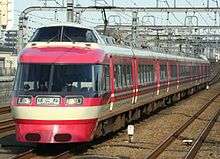 |
N/A | EMU | 70 | 110 | 1980 | Japan | Tokyo - Hakone | Odakyu Electric Railway | Yes | Yes | Yes | N/A |
| Odakyu 2000 series | |
N/A | EMU | 60 | 100 | 1995 | Japan | Tokyo - Hakone | Odakyu Electric Railway | Yes | Yes | Yes | N/A |
| Odakyu 30000 series EXE |  |
N/A | EMU | 75 | 120 | 1996 | Japan | Tokyo - Hakone | Odakyu Electric Railway | Yes | Yes | No | Centre gangwayed cab cars never modeled. Uses end car 1 and 10 cabs instead. |
Large amounts of post-release DLC was also distributed, providing routes, locomotives, wagons and sessios.
Gameplay issues
The original version contained many bugs. For example, the "front coupling bug", where the locomotive's front coupler would not work, the "white void bug", where the route scenery disappears, leaving a white void, and the "end-of-the-line bug", where the locomotive, if it crashes through the last buffers on the route, would fall into an empty void. There are also issues with the signalling and AI dispatching. The game is also notoriously unstable, with unusually high tendencies to hang or crash without reason, and display error messages incorrectly and/or at the wrong times. In many instances, out-of-place error messages, usually for missing files, will cause a crash at the wrong time. MSTS 1.2 addressed some of these issues.[3]
Updates
Version 1.2 added new items such as British and American rolling stock, namely the British Rail Class 50, British Rail Mark 1 Coaches, an EMD SD40-2 and general US freight cars, along with two new activities each for the SD40-2 and Class 50.
Reception
The game sold over a million units and is, despite its age, still very popular and has a large, active community.[4]
Mods
The game features mod support as routes, trains, cargoes, scenery, etc. are abundant in the game. The installment of the mods is quite tricky since they have to be loaded into set files like Routes for Routes and Trainset for Trains, rollingstock, consists, etc. Over 1000 mods were created for the game and are mostly hosted on large community sites such as trainsim.com, uktrainsim.com and elvastower.com, to name a few. Additionally, MSTS BIN, a community mod that aimed to add features and fix old MSTS bugs has since been released.
Microsoft Train Simulator 2
On May 7, 2003, Microsoft announced that it would be developing a sequel called Microsoft Train Simulator 2[5] and it was first demoed to the public at E3 on May 15.[6] Seemingly its main improvements were the addition of people to the game (e.g. passengers waiting at the stations, people operating the new locomotive roster, etc.), more realistic crashes and other accidents, and turntables. It was being developed by Kuju Entertainment, the original MSTS creators. Despite restructuring efforts at Kuju, the project was however handed over to Microsoft Game Studios on August 18, 2003.[7]
This project was ultimately halted, as the following statement on April 24, 2004 from Microsoft confirmed:
Microsoft Game Studios has halted the Windows-based game "Train Simulator 2.0." The decision to halt "Train Simulator 2.0" was made some time ago and was based on a long, hard and difficult look at our business objectives and product offerings. We remain focused on the simulations category with successful, platform-driving franchises such as "Microsoft Flight Simulator."— [8]
On January 19, 2007, Microsoft announced the relaunch of the Microsoft Train Simulator project. This time the game was being made in-house by ACES Game Studio (Microsoft Game Studios) known for its long line of Microsoft Flight Simulators, as a part of the "Games for Windows" initiative. The game would have used the Microsoft Flight Simulator X graphics engine and it was planned to be compatible with both Windows Vista and Windows XP. A post on the 'The Little Wheel Goes in Back' blog, written by one of the developers, on August 23, 2007 suggested the working title was 'Train Simulator 2'.[9]
On January 23, 2009, Microsoft announced that it was permanently closing ACES Game Studios, the internal development studio responsible for both Microsoft Flight Simulator and Microsoft Train Simulator. As a result, all future development on Train Simulator 2 (which was entering the final stages of development at the time of the closure) was immediately halted, marking the second time that the project was terminated. While Microsoft states that "they are committed to both the Flight Simulator and Train Simulator brands", it is unknown if the Train Simulator 2 project will ever be resurrected and completed sometime in the future. Many former employees of ACES Game Studios went on to join Cascade Game Foundry, a new company that was itself founded by two ACES alumni. Cascade Game Foundry focuses on developing entertainment simulations.[10]
Open Rails
Open Rails is a open-source freeware project launched, developed, maintained and nurtured by a team of volunteers and licensed under GPL.[11] Its project summary states the following:[12]
Open Rails is a train simulator that supports the world's largest range of digital content.
Accurate behaviour for steam, diesel and electric traction including trains with multiple locos.
Signals which correctly protect the train and permit complex timetabled operations.
Multi-user mode in which any timetabled train can be driven in person or by computer.
Key technical objectives are to be backward compatible with as well as extend all MSTS content.[13] It adds new features such as improved multiplayer and mouse controls along with a newer engine that has better graphics and more realistic physics than MSTS.[14] It is optimised to be able to take advantage of the features of newer CPUs, and can support more detailed models.
Open Rails 1.1 was released in 25 March 2016.[15] This release brings the following new features since Open Rails 1.0:[16]
- System Additions
- quick menu access to documentation.
- New options to:
- limit the safe speed through curves, including penalties.
- automatically correct faulty parameters in locomotives.
- New keyboard commands for locomotive control:
- to cut off all power.
- to cut off all brakes.
- multiplayer can now connect directly to domain names.
- Environment Additions
- Wagons may now have multiple "freight animations" attached, including the ability to be loaded and unloaded through player-triggered animations.
- Activities can now dynamically change the weather as a normal part of gameplay.
- Sound triggers have been added for brake pipes, cylinder cocks and more.
- 3D cab views are loaded by default, when present.
- New cab controls for gears and projected speed have been added.
- Locomotive Additions
- Support added for
- Auxiliary tenders
- Blended dynamic brakes
- EP brake partial release
- Engine brakes have been extended to work with tenders.
- Support added for
- Operation Additions
- Operators may:
- Switch control between all available player, AI and static trains in-game.
- Refuel from water troughs.
- Engage manual mode (signalling) whilst still moving.
- Restricted speed zones have been added.
- AI trains can request permission to pass signals at danger.
- Operators may:
- General Improvements
- Sound Performance:
- distance cut-off.
- a new looping algorithm.
- better compatibility with stereo/mono switching for cab/outside views.
- Dynamic Sounds
- Improved joining/splitting trains during an activity, with more options for the player and AI trains.
- Improved super-elevation
- Harmonic rocking replaces vibration.
- Several brake-related improvements for compatibility and accuracy.
- Sound Performance:
See also
- Train simulator – reference article to other train simulator products.
References
- ↑ Amazon sales page for MSTS
- ↑ Marchelletta, Courtney. "Fuill Product Review Microsoft Train Simulator". About.com. Retrieved January 20, 2009.
- ↑ Train Simulator Add-on page
- ↑ Hilliard, Kyle (6 September 2014). "Gears Of War's Rod Fergusson On the Franchise's Past And His Optimism For The Future". Game Informer. GameStop. Retrieved 7 September 2014.
- ↑ "Microsoft Train Simulator Review for PC". GameFAQs. Retrieved January 20, 2009.
- ↑ "Train Simulator 2 Impressions – PC News at GameSpot". uk.gamespot.com. Retrieved January 20, 2009.
- ↑ "Microsoft takes over Train Sim 2 – PC News at GameSpot". uk.gamespot.com. Retrieved January 20, 2009.
- ↑ "Train Simulator 2 canceled – PC News at GameSpot". uk.gamespot.com. Archived from the original on January 30, 2009. Retrieved January 20, 2009.
- ↑ "The Little Wheel Goes in Back : Guter Tag von Leipzig!". blogs.msdn.com. Retrieved January 20, 2009.
- ↑ "The Simulation Game – games TM". www.gamestm.co.uk. Retrieved April 2, 2012.
- ↑ "Discover - Open Rails". Open Rails. Open Rails. Retrieved 13 October 2016.
- ↑ "The Open Rails Open Source Project". Black Duck : Open HUB. Open Rails. Retrieved 13 October 2016.
- ↑ "Discover - Our Mission". Open Rails. Open Rails. Retrieved 13 October 2016.
- ↑ "Learn - FAQ". Open Rails. Open Rails. Retrieved 13 October 2016.
Why does my train operate differently in Open Rails?
- ↑ "Milestones: Open Rails". Launchpad. Open Rails. Retrieved 13 October 2016.
- ↑ "Discover - Version 1.1". Open Rails. Open Rails. Retrieved 13 October 2016.